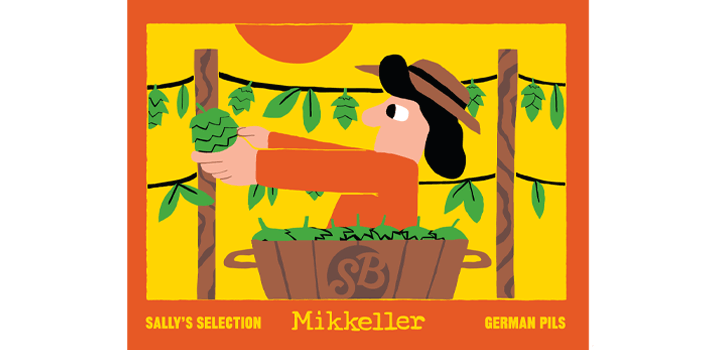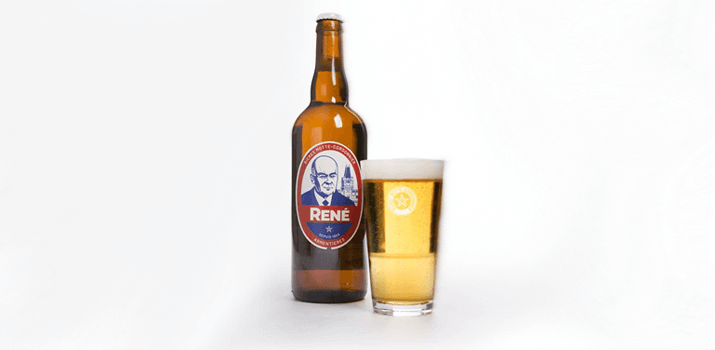With hundreds of beers under one roof, we like to take tasting notes of some of our favourites (or least favourites!) so they don't get lost in the haze of a great beer festival. Yes, it's a supremely beer-geeky thing to do but we think it's important in helping us discover what it is we like about beer and to push the envelope into trying new things.
We've already discussed in Week Four what exactly you're trying to observe in a beer: aroma, appearance, flavour and mouthfeel. As you'll see in the handy example below, it's broken up fairly easily so you can scribble your suggestions down quickly (note: people don't like it when you take room at the bar to write down your beer nerdery. Don't ask us how we know.) You'll notice that we like to make a note of the label design--it's helpful if it's a first try of a new brewery for you but, also, breweries put a lot of thought and effort into their design so taking a moment to appreciate it is a fun added extra!
We also suggest making a note of the ABV because breweries can tinker with their recipes from time to time and it can taste differently. Same goes for what sort of packaging it was served from: a cask version can quite often taste different from a bottled or kegged version. Try as a brewery might to be consistent sometimes packaging can change a beer's character a bit. That's a fun bit of tasting beer!
As you'll see, it's all pretty straight forward. Looking below, we've included a lot of terminology used to describe beer. In future lessons we'll get more in depth on what ingredient creates which qualities but, for now, here's a bit of vocabulary to get you going. Keep in mind, however, the most important description to remember--and write down--is how much you did, or didn't, like it!
Helpful Beer Descriptions
Here is a list of helpful descriptors to get you on your way to proper beer-geekery! This is not an all-encompassing list, just a few suggestions. The most important thing to know about tasting beer is that there are no wrong answers (well, mostly no wrong answers. A Russian Imperial Stout should never be described as “clear and as golden as the sun…” Then you’d be wrong.)
Aroma:
Malty, Grain, Biscuit, Roast, Toast, Caramel, Toffee, Nutty, Chocolate, Coffee Sweet, Spicy, Pepper, Clove, Earthy, Yeasty, Citrus, Orange, Grapefruit, Lemon, Pineapple, Tropical Fruits, Banana, Apricot, Pine, Resin, Mint, Grass, Straw, Floral, Fruity, Dried Berries, Alcohol
Appearance:
Clear, Hazy, Sparkling, Opaque, Cloudy, Big Head, Little Head, Thick Head, Dense Head (no jokes here!), Frothy Head, Substantial Lacing, No Lacing, Carbonation, No Carbonation. Colour: Straw, Pale Gold, Deep Gold, Amber, Dark Amber, Brown, Ruby Brown, Deep Brown, Black
Flavour:
Malty, Grain, Biscuit, Roast, Toast, Caramel, Toffee, Nutty, Chocolate, Coffee Sweet, Spicy, Pepper, Clove, Earthy, Yeasty, Citrus, Orange, Grapefruit, Lemon, Pineapple, Tropical Fruits, Banana, Apricot, Pine, Resin, Mint, Grass, Straw, Floral, Fruity, Dried Berries, Alcohol, Bitter, Balanced, Lingering
Mouthfeel:
Smooth, Rich, Creamy, Viscous, Oily, Effervescent, Tingly, Prickly, Dry, Sweet, Warming, Tongue-Coating, Full Body, Medium Body, Light Body
Ok! That was just a quick lesson this week to get you better prepared for tasting beer. Well, more better. Betterer. You get it! We'll see you next week at Beer Hawk University when we start to compare and contrast some major beer styles and perhaps have a cheeky taste. If you care to follow along perhaps grab a Celis White and a Schneider Weisse Tap 7 as we compare some famous wheat ales.





